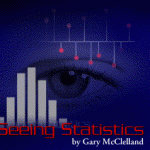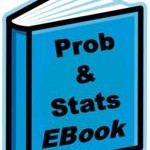Time series decomposition works by splitting a time series into three components: seasonality, trends and random fluctiation. To show how this works, we will study the decompose( ) and STL( ) functions in the R language.
Posted by Armando Brito Mendes | Filed under estatística
Bom texto com conclusões exclusivas
1. Re-sampling and Statistical Inference
- Main Result
- Sampling with or without Replacement
- Illustration
- Optimum Sample Size
- Optimum K in K-fold Cross-Validation
- Confidence Intervals, Tests of Hypotheses
2. Generic, All-purposes Algorithm
- Re-sampling Algorithm with Source Code
- Alternative Algorithm
- Using a Good Random Number Generator
3. Applications
- A Challenging Data Set
- Results and Excel Spreadsheet
- A New Fundamental Statistics Theorem
- Some Statistical Magic
- How does this work?
- Does this contradict entropy principles?
4. Conclusions
Tags: data mining, inferência, machine learning
Extracting Seasonality and Trend from Data: Decomposition Using R
Posted by Armando Brito Mendes | Filed under estatística, Investigação Operacional, lições, linguagens de programação, materiais ensino, materiais para profissionais
Uma excelente descrição da decomposição clássica com Python e R.
Understanding Decomposition
Decompose One Time Series into Multiple Series
Time series decomposition is a mathematical procedure which transforms a time series into multiple different time series. The original time series is often split into 3 component series:
- Seasonal: Patterns that repeat with a fixed period of time. For example, a website might receive more visits during weekends; this would produce data with a seasonality of 7 days.
- Trend: The underlying trend of the metrics. A website increasing in popularity should show a general trend that goes up.
- Random: Also call “noise”, “irregular” or “remainder,” this is the residuals of the original time series after the seasonal and trend series are removed.
Tags: engenharia, inferência, otimização, previsão
Controlling for test variables
Posted by Armando Brito Mendes | Filed under estatística, lições, materiais ensino, software
alguns apontamentos sobre testes com vars de controlo
3.2 Three (or more) variables
Introducing a third variable. Controlling for test variables. Elaboration.
Logical model is X → Y . T (the effect of X on Y controlling for T) where:
Y = Dependent variable
X = Independent variable
T = Test variable(s)
3.2.1 Elaboration
Tags: inferência, software estatístico
INTRODUCTORY STATISTICS book
Posted by Armando Brito Mendes | Filed under estatística, lições, materiais ensino
Um webBook sobre estatística com exercícios e exemplos em SPSS
INTRODUCTORY STATISTICS:
CONCEPTS, MODELS, AND APPLICATIONS
3rd Web Edition
David W. Stockburger
Missouri State University
@Copyright 2013 by David W. Stockburger
Tags: Estat Descritiva, IBM SPSS Statistics, inferência
Research Methods Knowledge Base
Posted by Armando Brito Mendes | Filed under estatística, materiais ensino, materiais para profissionais
Um webBook pensado para investigadores sobre temas de estatística
What is the Research Methods Knowledge Base?
The Research Methods Knowledge Base is a comprehensive web-based textbook that addresses all of the topics in a typical introductory undergraduate or graduate course in social research methods. It covers the entire research process including: formulating research questions; sampling (probability and nonprobability); measurement (surveys, scaling, qualitative, unobtrusive); research design (experimental and quasi-experimental); data analysis; and, writing the research paper. It also addresses the major theoretical and philosophical underpinnings of research including: the idea of validity in research; reliability of measures; and ethics. The Knowledge Base was designed to be different from the many typical commercially-available research methods texts. It uses an informal, conversational style to engage both the newcomer and the more experienced student of research. It is a fully hyperlinked text that can be integrated easily into an existing course structure or used as a sourcebook for the experienced researcher who simply wants to browse.
- Home
- Table of Contents
- Navigating
- Foundations
- Sampling
- Measurement
- Design
- Analysis
- Write-Up
- Appendices
- Search
Tags: análise de dados, b-learning, Estat Descritiva, inferência
A New View of Statistics
Posted by Armando Brito Mendes | Filed under estatística, lições, materiais ensino
Um webBook com montes de temas bem explicados
Mar 2013. Coming very soon: a slideshow and Excel workbook for an introductory course of 10 lectures on statistics. Aug 2011. Check out the following 2010 articles at Sportscience: assigning subjects to treatments in a controlled trial; regression vs limits of agreement in measure-comparison studies; magnitudes of effects derived from linear models. See the frame at right for links to much more, including the progressive statistics and research design articles. Previous updates…
New original approaches to statistics for researchers: the examples are taken from exercise and sport science, but the principles apply to all empirical sciences. Read more in the preface.
Feedback wanted: if you can’t understand something here, it’s my fault. Email me.
Become a license holder…eventually! Not yet. More…
Full Contents
Short Contents:
Preface: About These Pages
Summarizing Data
Simple Statistics & Effect Statistics
Dimension Reduction
Precision of Measurement
Generalizing to a Population
Confidence Limits & Statistical Significance
Statistical Models
Estimating Sample Size
Summary: The Most Important Points
Quiz
Reference: Hopkins, W. G. (2000). A new view of statistics. Internet Society for Sport Science: http://www.sportsci.org/resource/stats/.
Tags: análise de dados, Estat Descritiva, inferência, previsão
Probability and statistics EBook
Posted by Armando Brito Mendes | Filed under estatística, lições, materiais ensino
Um bom ebook com boas animações
SOCR Books: This is a General Statistics Curriculum E-Book, which includes Advanced-Placement (AP) materials.
Contents
- 1 Preface
- 2 Chapter I: Introduction to Statistics
- 3 Chapter II: Describing, Exploring, and Comparing Data
- 4 Chapter III: Probability
- 5 Chapter IV: Probability Distributions
- 6 Chapter V: Normal Probability Distribution
- 7 Chapter VI: Relations Between Distributions
- 8 Chapter VII: Point and Interval Estimates
- 9 Chapter VIII: Hypothesis Testing
- 10 Chapter IX: Inferences From Two Samples
- 11 Chapter X: Correlation and Regression
- 12 Chapter XI: Analysis of Variance (ANOVA)
- 13 Chapter XII: Non-Parametric Inference
- 13.1 Differences of Medians (Centers) of Two Paired Samples
- 13.2 Differences of Medians (Centers) of Two Independent Samples
- 13.3 Differences of Proportions of Two Samples
- 13.4 Differences of Means of Several Independent Samples
- 13.5 Differences of Variances of Independent Samples (Variance Homogeneity)
- 14 Chapter XIII: Multinomial Experiments and Contingency Tables
- 15 Chapter XIV:Bayesian Statistics
- 16 Chapter XV: Other Common Continuous Distributions
- 16.1 Gamma Distribution
- 16.2 Exponential Distribution
- 16.3 Pareto Distribution
- 16.4 Beta Distribution
- 16.5 Laplace (Double Exponential) Distribution
- 16.6 Cauchy Distribution
- 16.7 Chi-Square Distribution
- 16.8 Fisher’s F Distribution
- 16.9 Johnson SB Distribution
- 16.10 Rice Distribution
- 16.11 Uniform Distribution
- 17 Additional EBook Chapters (under Development)
Tags: análise de dados, Estat Descritiva, inferência
Seeing Statistics
Posted by Armando Brito Mendes | Filed under estatística, lições, materiais ensino, visualização
 Uma excelente maneira de aprender estatística com um webBook dinâmico e muito visual
Uma excelente maneira de aprender estatística com um webBook dinâmico e muito visual
Seeing Statistics ® is a new approach to teaching statistics using the World Wide Web. This webbook is based on three premises:
- The important principles of statistics are remarkably easy if they can be seen.
- Active involvement of the student facilitates learning.
- Statistics can be fun!
Most of the graphs and figures in this textbook are dynamic and under the control of the reader. Interacting with the graphs allows you to see the important statistical principles in action.
Rather than talk about it, it is best to view Seeing Statistics in action. To access Seeing Statistics, click on the “Enter Seeing Statistics” button to begin your exploration of Seeing Statistics!
Table of Contents
0. Introduction

1. Data & Comparisons

2. Seeing Data

3. Describing the Center

4. Describing the Spread

5. Seeing Data, Again

6. Probability

7. Normal Distribution
7. Outline
![]()
7.0 Introduction
![]()
7.1 Origins of Normal
![]()
7.2 Size and Shape
![]()
7.3 Working with the Normal
![]()
7.4 Means have Normal Distributions
![]()
7.5 Evaluating Normality (optional)
![]()
7.6 Review
![]()
7.7 Exercises
![]()

8. Inference & Confidence

9. One-Sample Comparisons

10. Two-Sample Comparisons
Tags: análise de dados, Estat Descritiva, inferência
Chance Lecture Video Series
Posted by Armando Brito Mendes | Filed under estatística, lições, materiais ensino
Bons vídeos ainda q antigos de alguns temas em probabilidade e estatística
This page has links to:
The talks featured below require the latest version of the Realplayer software. More particularly, they require that the “Realplayer plug-in” be installed in the plug-ins folder of your browser. If you do not have the “Realplayer plug-in,” a free version of Realplayer (which includes the plug-in) is available here
Tags: inferência, problemas
Science Isn’t Broken
Posted by Armando Brito Mendes | Filed under estatística, materiais para profissionais, visualização
Um bom blog com discussões interessantes e ilustrações muito boas
The Scientific Method 7:00 AM Aug 19, 2015
Science Isn’t Broken
It’s just a hell of a lot harder than we give it credit for.
Graphics by Ritchie King
If you follow the headlines, your confidence in science may have taken a hit lately.
Peer review? More like self-review. An investigation in November uncovered a scam in which researchers were rubber-stamping their own work, circumventing peer review at five high-profile publishers.
Hack Your Way To Scientific Glory
Tags: belo, inferência






